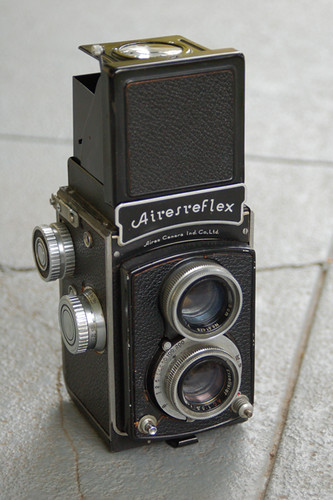Difference between revisions of "Airesflex"
Ivanbranco (talk | contribs) (year category) |
Hanskerensky (talk | contribs) m (→Links: Repaired Link URL) |
||
| (5 intermediate revisions by 2 users not shown) | |||
| Line 6: | Line 6: | ||
All have 75mm f/3.5 lenses, and focus by moving the entire lens assembly. | All have 75mm f/3.5 lenses, and focus by moving the entire lens assembly. | ||
| − | The ''' | + | = Models = |
| + | ==Aires Reflex Y== | ||
| + | The '''Aireswas Reflex Y''' (advertised in early 1951) has [[Fujita]] Excelsior triplet lenses and a [[Nishida]] [[Nishida shutters|Wester]] shutter (B, 1–200) with self-timer and flash synchronization.<ref>Lens and shutter: Hagiya, p.98.</ref> | ||
| + | The nameplate says ''AiresReflex''; under the nameplate, ''Aires Camera Ind. Co., Ltd.''<ref>Photograph: Hagiya, p. 92.</ref> | ||
| − | The '''Aires Reflex YII''' (advertised in spring and summer 1951) has an [[Nishida shutters|NKK]] shutter (same specifications as before, but with Kodak-style flash terminal) and a magnifying glass in the hood. The nameplate says ''Airesreflex.'' | + | ==Aires Reflex YII== |
| + | The '''Aires Reflex YII''' (advertised in spring and summer 1951) has an [[Nishida shutters|NKK]] shutter (same specifications as before, but with Kodak-style flash terminal) and a magnifying glass in the hood. | ||
| + | The nameplate says ''Airesreflex.'' | ||
| + | ==Aires flex YIII== | ||
The '''Aires Reflex YIII''' (advertised from summer 1951 until summer 1953) is based on the YII but has semi-automatic film advance (align the "start" arrow with a marker; thereafter wind, cock and fire). Early examples have the Excelsior lenses; later ones [[Coral]] lenses.<!-- nameplate in ad says Airesflex --> | The '''Aires Reflex YIII''' (advertised from summer 1951 until summer 1953) is based on the YII but has semi-automatic film advance (align the "start" arrow with a marker; thereafter wind, cock and fire). Early examples have the Excelsior lenses; later ones [[Coral]] lenses.<!-- nameplate in ad says Airesflex --> | ||
| − | The '''Aires Reflex Z''' (advertised from summer 1951 | + | ==Aires flex Z== |
| + | The '''Aires Reflex Z''' (advertised from summer 1951 to spring 1954) was based on the YIII. | ||
| + | It has a [[Seikosha Rapid]] shutter (B, 1-500, synchro) and, in most cases, a four-element [[Nikon|Nikkor]] lens (of which the view lens is f/3.2). Variant models include [[Zuiko]] and coral lenses, some made by Showa Koki. | ||
| + | Export models use [[Seikosha-MX|Seikosha-MXL]] shutters. The nameplate of the domestic model is marked ''AIRESFLEX'' and underlined with an extended A almost tangent to the X. The export nameplate is marked ''AIRES'' with ''reflex'' below it. | ||
| + | In 1953, when the Rolleicord IV cost $149 in the US, the Z with the coral lens cost $99, while the Z with the Nikkor cost $165.<ref>From ''US Camera,'' November 1953; cited by Hagiya, p.99.</ref> | ||
| − | The '''Airesflex U''' (later, '''Airesflex U''', advertised from autumn 1951 until autumn 1954) exists in a number of | + | ===Variation=== |
| − | * Zuiko, Seikosha-Rapid | + | * Nikkor, Seikosha-Rapid, AIRESFLEX |
| − | * Zuiko, Copal | + | * Zuiko, Seikosha-Rapid, AIRESFLEX |
| − | * Coral, Seikosha-Rapid | + | * Coral, Seikosha-Rapid, AIRE reflex |
| + | * Coral, Seikosha-MXL, AIRE reflex | ||
| + | |||
| + | ==Aires flex U== | ||
| + | The '''Airesflex U''' (later, '''Airesflex U''', advertised from autumn 1951 until autumn 1954) exists in a number of variations. | ||
| + | * Zuiko, Seikosha-Rapid (Us model) | ||
| + | * Zuiko, Copal (Uc model) | ||
| + | * Coral, Seikosha-Rapid (Ut model) | ||
* Coral, Copal | * Coral, Copal | ||
* Excelsior, Copal | * Excelsior, Copal | ||
| − | in which the Copal shutter has speeds of B, 1–200 with flash synchronization and self-timer. The nameplate says ''AIRESFLEX.'' | + | in which the Copal shutter has speeds of B, 1–200 with flash synchronization and self-timer. |
| + | The nameplate says ''AIRESFLEX.'' | ||
| + | |||
| + | ==Aires Automat== | ||
| + | The '''Aires Automat''' (advertised from spring 1954 until mid-1955) isthe most advanced. It is based on the Airesflex U; film advance is semi-automatic and it is wound by crank and has a self-cocking shutter. The shutter is a [[Seikosha-Rapid]] with M and X flash synchronization, and the lens is a Nikkor or Zuiko, Coral. The nameplate says ''AIRES AUTOMAT.'' In spring 1955 it was priced at ¥43,000 including case, remarkably high for a TLR.<ref>Advertisement placed in the July 1954 issue of ''Asahi Camera,'' reproduced in {{Kokusan}}, p.113. The IV appears in this ad together with the U and Automat, whose prices are not mentioned.</ref> | ||
| + | |||
| + | It was also sold by [[Sears]] as Tower25 (Tower Automatic TLR). | ||
| − | The '''Airesflex IV''' (advertised in the second half of 1954) is a simpler version, with a red window for film advance. It has Coral lenses and a new Copal shutter (B, 1–300, with self-timer and flash synchronization). The nameplate says ''AIRESFLEX'' and underneath it ''Model IV.'' In summer 1954 it cost ¥17,000 including case.<ref>Advertisement placed in the May 1955 issue of ''Asahi Camera,'' reproduced in {{Kokusan}}, p.114.</ref> | + | ==Aires flex IV== |
| + | The '''Airesflex IV''' (advertised in the second half of 1954) is a simpler version, with a red window for film advance. It has Coral lenses and a new Copal shutter (B, 1–300, with self-timer and flash synchronization) or Seikosha-Rapid. The nameplate says ''AIRESFLEX'' and underneath it ''Model IV.'' In summer 1954 it cost ¥17,000 including case.<ref>Advertisement placed in the May 1955 issue of ''Asahi Camera,'' reproduced in {{Kokusan}}, p.114.</ref> | ||
| − | The ''' | + | ==Aires flex IV SA== |
| + | The '''Airesflex IV SA''' is the export-receiving model of the Airesflex VI. | ||
{{Flickr_image | {{Flickr_image | ||
| Line 30: | Line 55: | ||
|image= http://farm7.staticflickr.com/6233/6218352870_dfc1458ea5_n.jpg | |image= http://farm7.staticflickr.com/6233/6218352870_dfc1458ea5_n.jpg | ||
|image_align= left | |image_align= left | ||
| − | |image_text= Aires Reflex Z | + | |image_text= Aires Reflex Z (Seikosha-MXL model) |
|image_by= Ghostavny | |image_by= Ghostavny | ||
|image_rights= cc | |image_rights= cc | ||
| Line 45: | Line 70: | ||
{{br}} | {{br}} | ||
| + | |||
==Notes== | ==Notes== | ||
<references /> | <references /> | ||
| Line 84: | Line 110: | ||
** [http://aya3photo.sakura.ne.jp/aya-2/aires-flex-y3_ca.html Airesflex YIII] | ** [http://aya3photo.sakura.ne.jp/aya-2/aires-flex-y3_ca.html Airesflex YIII] | ||
** [http://aya3photo.sakura.ne.jp/aya-2/airesflex-zniko_ca.html Airesflex Z] | ** [http://aya3photo.sakura.ne.jp/aya-2/airesflex-zniko_ca.html Airesflex Z] | ||
| − | * [http://www.hayatacamera.co.jp/monthlyphoto/201001/ Airesflex Z] at [ | + | * [http://www.hayatacamera.co.jp/monthlyphoto/201001/ Airesflex Z] at [https://www.hayatacamera.co.jp/ Hayata Camera Laboratory] |
* [http://blog.livedoor.jp/united3arrows/archives/51246734.html Advertisement for the Airesflex and Aires 35] dated 1954, reproduced in [http://blog.livedoor.jp/united3arrows/ Shashin-Bako] | * [http://blog.livedoor.jp/united3arrows/archives/51246734.html Advertisement for the Airesflex and Aires 35] dated 1954, reproduced in [http://blog.livedoor.jp/united3arrows/ Shashin-Bako] | ||
[[Category: Japanese 6x6 TLR]] | [[Category: Japanese 6x6 TLR]] | ||
| + | [[Category:120 film]] | ||
[[Category: Aires]] | [[Category: Aires]] | ||
[[Category: A]] | [[Category: A]] | ||
[[Category:1950-1959]] | [[Category:1950-1959]] | ||
[[Category:Unidentified year]] | [[Category:Unidentified year]] | ||
Latest revision as of 04:47, 25 August 2023
The Aires Reflex, Airesflex and Aires Automat are 6×6 TLRs made by Aires in the early 1950s. Until summer 1953, and perhaps later, these were distributed in Japan by Tōyō Shashinki-zai.
All have 75mm f/3.5 lenses, and focus by moving the entire lens assembly.
Contents
Models
Aires Reflex Y
The Aireswas Reflex Y (advertised in early 1951) has Fujita Excelsior triplet lenses and a Nishida Wester shutter (B, 1–200) with self-timer and flash synchronization.[1] The nameplate says AiresReflex; under the nameplate, Aires Camera Ind. Co., Ltd.[2]
Aires Reflex YII
The Aires Reflex YII (advertised in spring and summer 1951) has an NKK shutter (same specifications as before, but with Kodak-style flash terminal) and a magnifying glass in the hood. The nameplate says Airesreflex.
Aires flex YIII
The Aires Reflex YIII (advertised from summer 1951 until summer 1953) is based on the YII but has semi-automatic film advance (align the "start" arrow with a marker; thereafter wind, cock and fire). Early examples have the Excelsior lenses; later ones Coral lenses.
Aires flex Z
The Aires Reflex Z (advertised from summer 1951 to spring 1954) was based on the YIII. It has a Seikosha Rapid shutter (B, 1-500, synchro) and, in most cases, a four-element Nikkor lens (of which the view lens is f/3.2). Variant models include Zuiko and coral lenses, some made by Showa Koki. Export models use Seikosha-MXL shutters. The nameplate of the domestic model is marked AIRESFLEX and underlined with an extended A almost tangent to the X. The export nameplate is marked AIRES with reflex below it. In 1953, when the Rolleicord IV cost $149 in the US, the Z with the coral lens cost $99, while the Z with the Nikkor cost $165.[3]
Variation
- Nikkor, Seikosha-Rapid, AIRESFLEX
- Zuiko, Seikosha-Rapid, AIRESFLEX
- Coral, Seikosha-Rapid, AIRE reflex
- Coral, Seikosha-MXL, AIRE reflex
Aires flex U
The Airesflex U (later, Airesflex U, advertised from autumn 1951 until autumn 1954) exists in a number of variations.
- Zuiko, Seikosha-Rapid (Us model)
- Zuiko, Copal (Uc model)
- Coral, Seikosha-Rapid (Ut model)
- Coral, Copal
- Excelsior, Copal
in which the Copal shutter has speeds of B, 1–200 with flash synchronization and self-timer. The nameplate says AIRESFLEX.
Aires Automat
The Aires Automat (advertised from spring 1954 until mid-1955) isthe most advanced. It is based on the Airesflex U; film advance is semi-automatic and it is wound by crank and has a self-cocking shutter. The shutter is a Seikosha-Rapid with M and X flash synchronization, and the lens is a Nikkor or Zuiko, Coral. The nameplate says AIRES AUTOMAT. In spring 1955 it was priced at ¥43,000 including case, remarkably high for a TLR.[4]
It was also sold by Sears as Tower25 (Tower Automatic TLR).
Aires flex IV
The Airesflex IV (advertised in the second half of 1954) is a simpler version, with a red window for film advance. It has Coral lenses and a new Copal shutter (B, 1–300, with self-timer and flash synchronization) or Seikosha-Rapid. The nameplate says AIRESFLEX and underneath it Model IV. In summer 1954 it cost ¥17,000 including case.[5]
Aires flex IV SA
The Airesflex IV SA is the export-receiving model of the Airesflex VI.
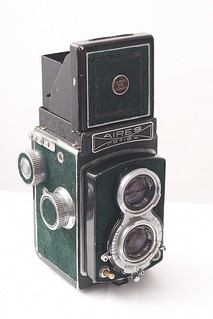
|
| Aires Reflex Z (Seikosha-MXL model) image by Ghostavny (Image rights) |
 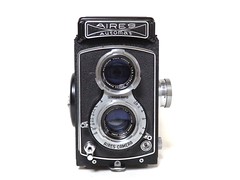 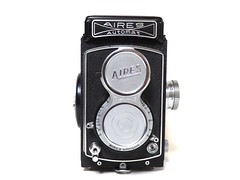
|
 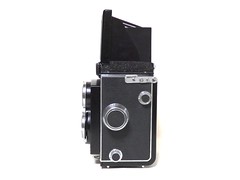 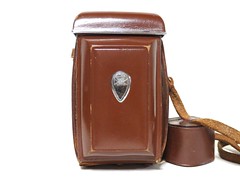
|
| Aires Automat 6x6cm, Nikkor f3.5/75mm lens Images by yalluflex. (Image rights) |
Notes
- ↑ Lens and shutter: Hagiya, p.98.
- ↑ Photograph: Hagiya, p. 92.
- ↑ From US Camera, November 1953; cited by Hagiya, p.99.
- ↑ Advertisement placed in the July 1954 issue of Asahi Camera, reproduced in Kokusan kamera no rekishi, p.113. The IV appears in this ad together with the U and Automat, whose prices are not mentioned.
- ↑ Advertisement placed in the May 1955 issue of Asahi Camera, reproduced in Kokusan kamera no rekishi, p.114.
Sources / further reading
- Asahi Camera (アサヒカメラ) editorial staff. Shōwa 10–40nen kōkoku ni miru kokusan kamera no rekishi (昭和10–40年広告にみる国産カメラの歴史, Japanese camera history as seen in advertisements, 1935–1965). Tokyo: Asahi Shinbunsha, 1994. ISBN 4-02-330312-7. 347–53. (See also the advertisement for item 355.)
- Hagiya Takeshi (萩谷剛). "Airesu no kamera: Yarūfurekkusu soshite 6×6-han niganrefu, 35mm kamera e (アイレスのカメラ:ヤルーフレックスそして6×6判二眼レフ、35mmカメラへ, The Aires cameras: From the Yallu Flex to 6×6 TLRs and 35mm cameras). Chapter 5 of Zunō kamera tanjō: Sengo kokusan kamera jū monogatari (ズノーカメラ誕生:戦後国産カメラ10物語, The birth of the Zunow camera: Ten stories of postwar Japanese camera makers). Tokyo: Asahi Sonorama, 1999. ISBN 4-257-12023-1 First published in issue 22 (September 1992) of Kamera rebyū: Kurashikku kamera senka (カメラレビュー・クラシックカメラ専科).
- The Japanese Historical Camera. 日本の歴史的カメラ (Nihon no rekishiteki kamera). 2nd ed. Tokyo: JCII Camera Museum, 2004. P.60. The Airesflex Z appears (with the Minolta Flex IIB) for its semi-automatic film advance.
- Watakushi no ni-gan-refu kamera-ten (私の二眼レフカメラ展, Exhibition of twin lens reflex cameras). Tokyo: JCII Camera Museum, 1992. (Exhibition catalogue, no ISBN number.) P.26.
Links
In English:
- Aires Camera Co. TLRs at tlr-cameras.com
- Airesflex series, in particular the Airesflex Z and Aires Automat, in Hiura Shinsaku's camera site. (See also Hiura's index.html tests of the Nikkor-Q.C. lens on the Airesflex Z [comments in Japanese], and sample photos from the Aires Automat.)
- Airesflex PDF instructions from www.OrphanCameras.com
- Airesflex (Z?) with Coral lens advertised for USD $99.50, in December, 1953, U.S. Camera magazine, pg. 36
In French:
In English and Italian:
- Aires cameras including the TLR models, at Massimo Bertacchi's Innovative cameras
In Swedish:
- TLR cameras (with an Airesflex) at Samlarkameror.com
- Aires Automat, lot no.111 of auction no.31 (2 November 2008) by LP Foto
In Japanese:
- Airesflex Z in the Camera database of the Center of the History of Japanese Industrial Technology
- Airesflex IV from this page of old advertisements
- Pages at Takasaki Motohiro's camera repair/maintenance site:
- Airesflex specifications (archive.org) at Japan Family Camera
- Airesflex Z repair, by H. Arai
- Pages at Aya's camera site:
- Airesflex Z at Hayata Camera Laboratory
- Advertisement for the Airesflex and Aires 35 dated 1954, reproduced in Shashin-Bako
